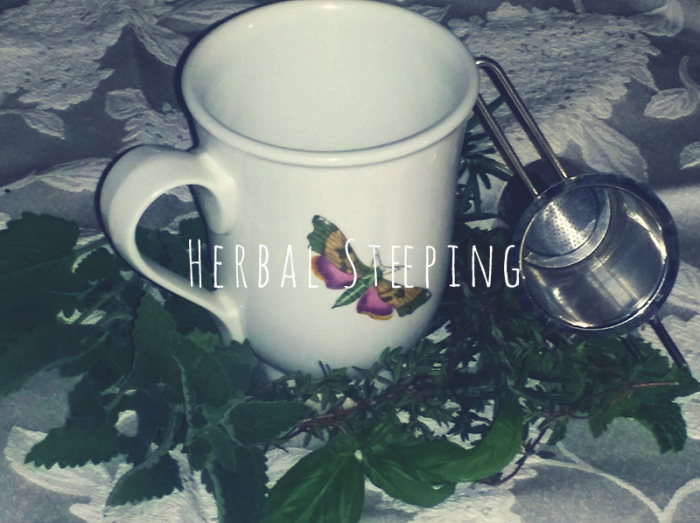The very first tea was created thousands of years ago. While many of us incorporate tea in our diets, most of us are probably unaware that we could be doing something very simple to add nutritional value and a huge surge of flavor to our next cup.
Herb steeping is a first step on the route to full tea infusion. If you’re looking to gain some health benefits and to add a bit of flavor…why not give herbal steeping at try??
Full tea infusion consists of taking several herbs, fruits, spices, and tea. Normally, this involves letting the mixture sit for a considerable amount of time, from several hours to even a day or so. While this practice offers numerous health benefits, it can be difficult for a beginner, from figuring out the correct blends to the steeping time. Finally, the taste can be very overwhelming when one’s palate is not accustomed to that level of intensity.
For beginners, “partial infusion” of steeping herbs into a cup of tea offers an extremely easy, and less intense alternative. Use this process and make your reliable, trusty cup of tea a little more exciting.
Start out with your traditional back or green tea. While any tea can be used as a base, starting out using a simple basic black or green tea is a great place to begin. Most of us are familiar with the flavors so the exact level of additional zest can be easily determined. The user can decide by simple trial and error whether to steep a longer or shorter amount of time.
Next, either purchase empty tea bag filters, or if you prefer less waste, and are interested in being more ecologically responsible, invest in a metal steeper.
2 important tips to remember- The amount of herb you and the length of time you steep are crucial in determining your tea’s flavor.
Using more of your chosen herb and steeping longer will impart more health benefits but also more bitterness. If you are new to the process, follow this general rule: Less is more. Less herbs, and less time steeping.
As you progress, your taste buds will change. You can increase both as your preferences change. There’s nothing like an overly strong and bitter tea. The pungent flavor won’t be easy to purge from your memory.
If you find that the steeped herb is hard to detect, simply add a little more next time. Also, if the combination seems off or strange, simply try another herb. Once you find a few favorites, and are comfortable, try switching up the base tea.
Step 1- Add your tea
Steps one and two are to be performed seconds apart. To simplify things you can use the same steeper. Loose teas are a favorite with true tea aficionados, simply add your herb on top of the loose tea in the steeper. However if you have pre-made tea in bags, feel free to use those, and add the steeper with herbs separately.
Step 2- Steep your Herbs
Below you’ll find two great “beginner” steeping herbs to try and two for the more adventurous and/or experienced.
Mint- Spearmint or peppermint. Both used to treat stomach ailments, they also have antiviral, antifungal properties. If you are using mint for the first time, remember that spearmint is a little more subtle, so it’s a safer choice.
The fresh invigorating flavor will not only layer on health benefits but so much flavor. Try it without adding any sweetener. You may find that the extra surge is flavor enough, without the need to add anything more to your mélange.
Thyme- Thyme is also great for stomach ailments, as well as skin disorders and throat problems. Another wonderful benefit of this important herb is that it will disinfect your mouth, reducing unpleasant odors. It has an earthy, citrusy taste which is also subtle, perfect for someone new to herbal steeping.
The last two are also amazing herbs but require a bit more attention as they can quickly overwhelm your tea. The idea here is to add a layer of flavor and some nutrients. If you overcome the entire tea’s flavor, the unaccustomed palate may find the result shocking- and not in a good way.
Rosemary– This beneficial herb has been used to treat high blood pressure, headaches and skin disorders. Rosemary is also helpful in treating digestive issues. It’s actually related to mint but carries a much more intense piney flavor, and a little goes a very long way.
Basil- Assists in ridding your body of unwanted bacteria. It has many antioxidant and antiviral properties as well. It has been used historically to treat asthma and diabetes. The herb had peppery and minty notes, along with a dash of clove.
Although there are many types of basil out there, try sweet basil, since it’s the flavor most westerners are accustomed to.
Have you ever tried herbal tea steeping? What flavor combinations would you like? 🙂
Also by Alex: Fail-Proof Tips for Making the Best Juice Blends
How to Make Drinking Water More Exciting
More in tea: 5 Unusual Teas to Try and Their Benefits
Best Caffeine Free Beauty Teas
__
Photo: Alexandra Kudukis

